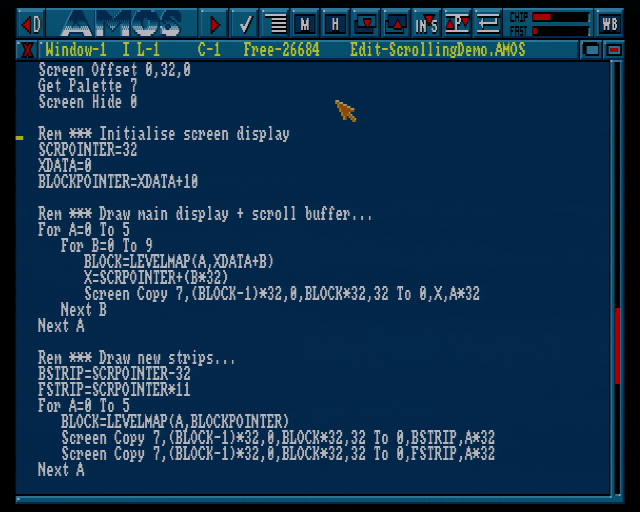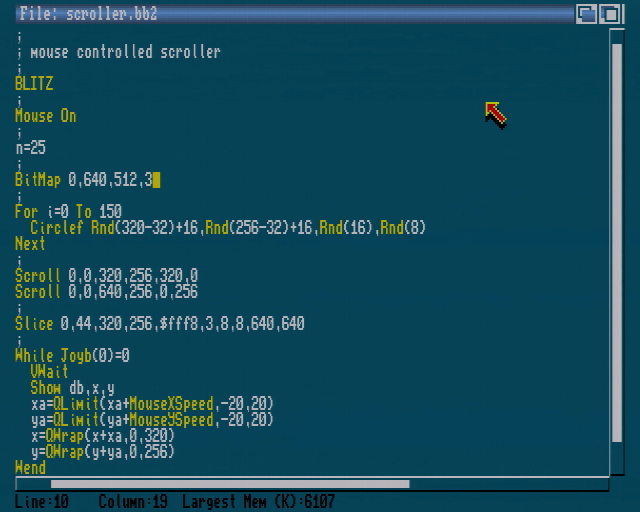Initial-ish Impressions: AMOS Pro vs Blitz Basic 2
I find the plethora of programming languages available for the Amiga fascinating. Especially so, the large amount of BASIC variants. The top two options for games specifically are definitely AMOS and Blitz Basic from what I can see.
Some other options such as HiSoft BASIC also seem to be of good quality (HiSoft BASIC actually does interest me quite a bit as it was advertised as being QuickBASIC compatible while not being mostly shit like Amiga BASIC from what I understand... but I will explore it later). However, it seems most people at the time settled with either AMOS or Blitz.
I've personally spent more time with AMOS so far, but this weekend I spent a bit of time with Blitz Basic and figured I'd jot down my initial thoughts about each.
None of the points below are listed in any particular order, and it is all just based on my impressions, opinions and experiences from only a limited amount of time looking at each thus far. Also note that the below screenshots show my own customizations, they are not how the "out of the box" experience is exactly.
AMOS Pro

- Editor looks very polished. Especially as compared to the earlier (non-pro) versions. Lots of customization available with the ability to load "accessories", which, due to AMOS's overwhelming popularity back then, there are a great many to choose from.
- The editor is not without it's quirks. For one I dislike the automatic formatting (which you cannot turn off, and is
likely a result of the fact that the editor is obviously tokenizing your code as you type it in). More specifically,
I don't like how it removes excess whitespace and uppercases variable names, e.g. if I type
ship_x = foo + bar, it will always auto-format toSHIP_X=FOO+BAR. - AMOS Pro thankfully added
INCLUDEsupport for modularizing your code, but even so, you'll probably end up with big source files. Luckily the editor allows you to collapseProcedures (though you might not actually want to use them in all cases, since this is a platform where the performance difference betweenGOSUBand aProcedurecall can really matter!) - Following up on the above mentioned "accessories", the developer of AMOS provided some that serve as tools for sprite/image editors, map editors, font editors, and more. These are easily accessible from within the IDE.
- Lots of documentation in the forms of a beefy user manual and many other published books and sample code. Even built in fully-browseable help within the editor itself.
- Easily accessible "direct mode" available from the editor to allow quick experimentation (it also doubles as a debugging tool when your program encounters an error).
- Very extensive set of functions with what looks like a decent abstraction over the underlying hardware (from my early impressions anyway). I personally think this is a pro and a con (a pro for when you're starting out as it's easier to jump into and a con because I suspect it won't help you that much if you move onto e.g. C/assembler later on). This abstraction covers things like asset loading as well which is certainly convenient.
- The AMOS BASIC dialect is overall good, though lacking in some key areas. For example, no
SELECTandTYPE. Somewhat odd syntax for callingProcedures (SUBs andFUNCTIONs from QBasic) and accessing the return value (if any). You cannot put comments just anywhere (well, unless you useREMI guess, though in my opinion,REMmakes the code a bit harder to read). A comment written using'must be on it's own line. - Quirky / annoying support for accessing system libraries, but it is somewhat workable.
- Doesn't integrate with the OS, kind of does it's own thing with it's own totally custom GUI. This also extends to programs developed with it if they do things like pop up file requestors which will be quite alien-looking.
Blitz Basic 2

- Much more powerful language that is clearly built to enable high performance as a primary goal. Blitz's BASIC dialect
is excellent for the time in my opinion. Support for
TYPE's, pointers, inline assembly, and more. - The language is built for a compiler and there doesn't appear to be any interpreter at all (even when running from the IDE, you can't just choose "Run" unless you've already compiled your program). Thus performance is higher from the get-go.
- The editor is minimal, which is nice. Though it definitely is unique in a number of ways, and I don't mean that in a good way, at least not if you like me are accustomed to modern text editor standards. You cannot always hit Return to insert a new line (only if you're at the end of the current line), else you need to press Amiga+I to insert a new line or hit Shift-Return. Using the Backspace or Delete keys to remove lines is not possible, you instead must use a menu command (or press Amiga+D) to delete lines. Selecting text for copy+paste is kind of quirky, requiring you to select the text to be copied then go and find the location where you want it copied to (the paste location) and place the cursor there (moving the cursor does not unselect text) and then issue the menu copy command (or Amiga+C). There is a specific menu command for unselecting text. I'm sure you can get used to all this, but I point it out only as it's pretty different from what most people would be used to.
- The editor has syntax highlighting! Only two colours though: regular text and tokens.
- The editor has a side pane that pops up when your program has labels (for
GOTO/GOSUBonly, doesn't showStatementorFunctionnames for some weird reason). Clicking the names in this pane scrolls immediately to that label. Thusly you can also use this as a "bookmark" list of sorts. - The editor is incredibly unstable. It crashes a lot, in a lot of different situations, forcing you to do a Ctrl-Amiga-Amiga reset. I've had the editor crash when clicking Project -> New, when switching back to the Workbench, when compiling a program, many times when debugging code with direct mode (in all cases, this was incredibly simple code, not even using "blitz mode"). Worth noting, I've tried four different versions of Blitz2, the 1.6 Amiga Format disk release, a 1.7 release, 2.0 and 2.1. I actually also tried installing Workbench 3 temporarily just so I could try the updated Ted version and also the "SuperTed" update, hoping that these would improve things. However, all of these also were incredibly unstable for me.
- The standard library appears to be a bit "closer to the metal" then AMOS, but it still abstracts the hardware quite a bit. I suspect that moving from Blitz Basic to C/assembly would be a bit easier. In fact, the mere ability to use inline assembly with such ease basically anywhere in your code means that you possibly wouldn't even need to switch to C or go full-out with pure assembly unless your performance requirements were quite extreme.
- The editor has built in help which is either limited to parameter lists only, or in later versions even has a browseable function index with descriptions and (few) examples.
- There is not nearly as much documentation out there for Blitz Basic as there is for AMOS. A common complaint about Blitz Basic from what I've read is that it's harder to get started with, though I think for an experienced programmer that this difference is moot. Probably the smaller amount of example code that's out there would be the biggest annoyance.
- The debugger and direct mode support looks a fair bit more unpolished than AMOS at first glance, but is definitely more advanced. Especially with a debugger update that is available for release 2.1 (though coincidentally I found this debugger update appeared to reduce stability somewhat).